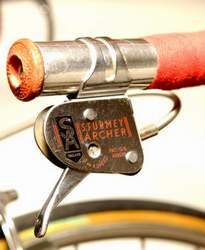Alternative attachment and routing of cables
Posted: Monday 21st September 2020
Some time ago I achieved a long time ambition of acquiring a Gillott ‘Fleur de Lis’ Superbe frameset. As it was a track model I wanted to convert it for road use.

In the Fifties, keeping the fixed gear, I would have just attached a front brake, possibly fitted mudguards, and off I would go. This frame was fitted with mudguard eyes which was a peculiar fitment to track frames in those days, and the frames were usually termed as ‘road/path’. Living on the foothills of the Lower Mendips me little legs cannot cope with a single fixed, so I needed to fit gears.

Now I know some people fit derailleur gears to frames with rear track ends but I think it looks messy and trying to remove the rear wheel to repair a puncture is a pain in the neck!
So, a hub gear it had to be – which I hated with a passion! Aesthetically the hub gear looks okay on a track frame but the conventional routing of the gear cable, along the top tube, offends my eye as does the position where the gear trigger is normally placed, just below the righthand brake lever. Why not route the gear cable via the bottom bracket as most of the derailleur gear cables are routed? Hardly an original thought as ladies frames have always been fitted that way!
Mentioning derailleurs, why not fit the gear trigger to the end of the bars a la Campagnolo/Simplex/Cyclo bar end gear shifters! In that position it is easier to engage bottom gear and it doesn’t foul the brake lever when riding on the ‘hoods’ (Fig.1 – left).

Now to fit the rear brake. The seatstay bridge had already been drilled – I must admit that I wouldn’t have been happy drilling the bridge, but as it had already been done, so be it.
There were no cable stops fitted to the top tube so the simplest method of fitting the brake cable would have been to use rubber frame cable bands or the much tidier frame cable clips.
But, as we all know, the less outer cable that is used the more efficient the brake is, so I fitted two Sturmey Archer cable stops (Fig.2 right). Much tidier than the other two options and much more efficient.
This frame was designed for sprints and tubs. Consequently, when I came to fit my 27″ wheels, which were fitted with 1¼” High Pressure tyres, the front jammed against the fork crown! (Fig.3 – below).
Because of economic reasons I didn’t really want to fit sprints and tubs, but by fitting a 27″ x 1″ tyre to the front wheel the problem was solved (Fig.4 – below).
Or so I thought. Unfortunately the brake shoes, though fitted to the top of the yoke, were to low to work (Fig.5 – below).
Now I know I could have filed the top of the yoke to allow the brake block to be fixed higher but that would have ruined the caliper and I don’t think the brake shoe would have been able to reach the rim. So I had some brass ‘L’ brackets made (Fig.6 – below) that could be attached to the brake yoke in the normal fashion using a 2 BA nut and bolt and fitted some ‘Westwood’ rim brake shoes to the top of the ‘L’ (Fig.7 – below). Hey Presto I was ready to go! What was it ‘Heath Robinson’ said?
I have been riding the bike for a couple of years now and I love it, I just wish I could turn the clock back to the Fifties and do the bike some justice. If you decide to go down this route, remember that Sturmey Archer made two different sizes in cable stops – to fit top tubes and to fit down tubes.
Posted: Monday 21st September 2020
This article appears in the following categories.
Upcoming Events
Whether you are looking for a gentle social meet up, or a 100-mile ride browse the community’s upcoming events and plan your next weekend outing.





